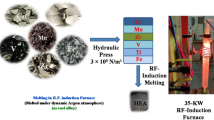Abstract
The majority of the binary intermetallic compounds of aluminium with metals from the First and Third Long Periods and with Mg, Y, Pd, Ag, Th and U have been prepared, hardness tested and oxidized in air at successively higher temperatures. From the oxidation results the temperature corresponding to a weight change of 1 mg cm−2 over 4 h was determined by interpolation. The compounds with the highest temperature parameters (over 900‡ C) are formed with Cr→Cu, Ir→Au and Gd→Dy from the 3d, 5d and 4f transition series respectively, and, for d-transition compounds, at or near the equi-atomic compositions. Hardness is highest (over 800 kg mm−2) for compounds of the same metals except that high values are general amongst 5d compounds. Throughout the Third Long Period, and for Fe, Co and Ni, hardness (and, for rare earth compounds, the temperature parameter also) is most often highest where Al/M is equal to or approximates to 2/1. A brief survey of melting points and structures is presented, in addition to a classification of compounds in terms of the ratio of the temperature parameter to compound or oxide melting points, the use of synoptic diagrams relating incidence of oxidation mode to Al/M ratio and atomic number, and a division of the Periodic Table consonant with the behaviour of these and other compounds. Appendices include hardness data for many unalloyed transition elements, and oxidation and hardness data for the three pseudo-binary systems Al(Ni, Pd), Al2(La, Gd) and Al2(Gd, Lu).
Similar content being viewed by others
References
H. E. N. Stone,J. Mater. Sci. 9 (1974) 607.
Idem, ibid 7 (1972) 1147.
Idem, J. Phys. (E) 4 (1971) 1058.
M. Hansen andK. Anderko, “Constitution of Binary Alloys” (McGraw-Hill, New York, 1958) and supplements edited by R. P. Elliott (1965) and F. A. Shunk (1969).
W. Hume-Rothery andB. R. Coles,Adv. Phys. 3 (1954) 197.
G. V. Raynor, Paper 3A, “The Physical Chemistry of Metallic Solutions and Intermetallic Compounds”, N.P.L. Symposium No. 9, 1958 (HMSO, London, 1959) p. 16.
K. A. Gscheidner Jun, “Rare Earth Alloys” (van Nostrand, Princeton, 1961) p. 100.
K. H. J. Buschow,Philips Res. Reports 20 (1965) 337.
K. H. J. Buschow andJ. H. N. Van Vucht,ibid 22 (1967) 233.
O. J. C. Runnals andR. R. Boucher,J. Less Common Metals 13 (1967) 431.
H. E. N. Stone,J. Mater. Sci. 8 (1973) 1009.
W. Hume-Rothery, R. E. Smallman andC. W. Haworth, “The Structure of Metals and Alloys” (The Metals and Metallurgy Trust, London, 1969) p. 130.
A. D. Caplin, G. Grüner andJ. B. Dunlop,Phys. Rev. Letters 30 (1973) 1138.
A. F. Wells, “Structural Inorganic Chemistry” (O.U.P., Oxford, 1962) pp. 971, 999.
H. E. N. Stone, unpublished work.
Sir J. Dewrance,J. Inst. Metals 37 (1927) 21.
C. H. Desch, “Metallography” (Longmans, Green, London, 1942) p. 384.
Idem, ibid p. 110.
Idem, ibid, p. 106.
C. J. Smithells (Ed.), “Metals Reference Book” (Butterworths, London, 1962) p. 893.
L. E. Samuels, “Metallographic Polishing by Mechanical Methods” (Sir Isaac Pitman, London, (1967) p. 172.
H. H. Read (Ed.), “Rutley's Elements of Mineralogy” (Thomas Murby, London, 1939).
W. Roberts,Trans. Brit. Ceram. Soc. 64 (1965) 56.
A. F. Wells, “Structural Inorganic Chemistry” (O.U.P., Oxford, 1962) p. 245.
R. H. Taylor,J. Phys. (F) 3 (1973) 110.
Author information
Authors and Affiliations
Rights and permissions
About this article
Cite this article
Stone, H.E.N. The oxidation resistance, hardness and constitution of metallic aluminides. J Mater Sci 10, 923–934 (1975). https://doi.org/10.1007/BF00823208
Received:
Accepted:
Issue Date:
DOI: https://doi.org/10.1007/BF00823208




